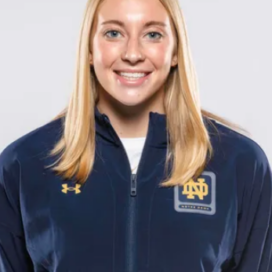Game Changer: How Data Analysis Revealed Key Differences Between Men’s and Women’s Tennis
Author: Marshall King

Maggie Fielder 2023 Notre Dame Graduate
How Data Became a Game Changer
Maggie Fielder has played tennis since she was three years old, but sees the game a little differently because of her recent research.
She used a huge data set including tournament results from 1978 to 2020 in both the men’s and women’s professional tours. It included all sizes of tournaments and granular information such as surface types, aces, and double faults. After scrubbing the data and restructuring it to be more qualitative, she ran logistic regression models on the men’s and women’s results separately.
“When I first started this project, I didn’t really think there would be a huge difference between men’s and women’s. “I played tennis my whole life. I’ve watched a lot of tennis,” said the 2023 Business Analytics graduate who will go to work at PriceWaterhouseCoopers as a tech consultant in the cyber risk and regulatory division.
Yet she found a lot of differences between the men’s and women’s games.
Difference Between Men’s and Women’s Games
For men, the main driver in outcomes of matches was breakpoints, when the person receiving the serve overcomes odds to score. “It makes a lot of sense because men’s tennis is really a game of power,” she said. “They’re taller and stronger typically than women. So serve games are very important. And men tend to hold serves, so it really is a battle of serves.”
On the women’s side, aces were the biggest driver of success. When a woman can add power to their serves, they are more typical to hold their serve and win games. “That will really affect the outcome of the match,” she said.
Fielder used the R programming language for her project and sees opportunities to expand the scope even more. A researcher could use the data to focus on major tournaments such as Wimbledon, the U.S. Open, or the French Open. Fielder also believes it would be interesting to study the impact of court surface types on results.
What is Next for Fielder?
Learning that finesse in the men’s game and power in the women’s game were primary predictors of success, was meaningful to Fielder. “The more I thought about it when I saw the results, it all kind of made sense,” she said. “Those differences really do shine through men’s and women’s tennis. I learned so much from doing this project about something I love. It was just fun. It didn’t feel like work or homework and so I had an awesome time doing it.”
Her experience at Notre Dame was surrounded by classmates and professors who were willing to help her succeed. She loved the Sports Analytics class taught by Martin Barron, assistant teaching professor at the Mendoza College of Business.
She spent two years doing sports analytics for the Notre Dame football team, one of the few females to do so. She hopes that after gaining some experience she’s able to work in the field.




